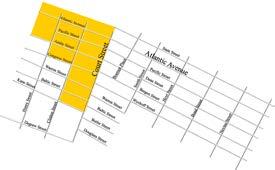HISTORIC PRESERVATION STUDIO II
Key Factors in Urbanization Development of Transporation and Infrastructure Early Waterways Waterways provided the earliest transportation to and from Brooklyn. Cornelis Dircksen operated the earliest known commercial rowboat ferry between lower Manhattan and what was then called Breuckelen, beginning in 1642.1 Dircksen, a Dutch settler, used his ferry to allow farmers to transport wheat, tobacco, and cattle from Long Island farms to New Amsterdam, the main Dutch outpost at the tip of Manhattan.2 In 1704 the road to the ferry was officially laid out in Brooklyn: the ‘Road to the Ferry’ or the ‘Road to Jamaica’ represented the main street in Brooklyn spanning from the Ferry landing to Jamaica and then on to eastern Long Island.3 In 1789 the city refused to renew the lease with then ferrymaster Adolph Waldron, and instead established the Catherine Ferry, known as the ‘New Ferry’ in 1795. The establishment of this new ferry resulted in the growth of a small settlement along the waterfront beneath what is known today as Brooklyn Heights. This area, once occupied by large landowners and farmers, had become more commercially active since before the Revolutionary War, and contained a large public market and adjacent slaughter-houses.4 The presence of the ‘New Ferry’ prompted further development of this area. In 1814 the New York and Brooklyn Steamboat Ferry Association introduced the “Nassau”, the first steam-propelled ferry on the East River. The “Nassau” traveled between Fulton Street in Brooklyn and Fulton Street in Manhattan. This new ferry service could not only accommodate hundreds of passengers, but could transport wagons and horses as well. Additionally, new steam technology dramatically reduced the travel time between Brooklyn and Manhattan from an hour and a half down to just eight minutes.5 The steam-powered ferry provided fast, reliable, and inexpensive service, which allowed Brooklyn to become one of the world’s first “commuter suburbs” and initiated an era of rapid growth in Brooklyn.6 Merchants, professionals, workers, and immigrants moved their families to Brooklyn and traveled by ferry to their daily jobs in Manhattan. Within less than 50 years, what began as a village had grown into the third-largest city in America, in large part due to the introduction of the ferry system.7 By 1819 the Nassau ferry was experiencing frequent delays due to the overcrowding of boats, which by then were transporting everything from passengers to cattle to horses, and products such as cotton, lumber, and naval stores. In response to the increasing complaints from passengers, a new ferry called the Steamboat William Cutting opened in 1819.8 As the waterfront continued to develop into a hub of transportation and commerce, more ferry service was added. In May of 1836 the South Ferry Company established the South Ferry, which connected Lower Manhattan to the foot of Atlantic Avenue in Brooklyn and the month-old Jamaica Railroad .9 Then in 1839, the New York and Fulton Ferry Company merged to form Brooklyn Union Ferry Company, managing the South Ferry and Fulton Ferry under one company.10 In 1854 the Union Ferry of Brooklyn consolidated the Fulton, South, Main, and Hamilton Avenue ferries under one company.11
Curve at Brooklyn Terminal, 1898 source: A Picture History of the Brooklyn Bridge
1 Everdell, William R. (1973). Rowboats to rapid transit: a history of Brooklyn Heights. Brooklyn, NY: Brooklyn Heights Association. 2 http://www.brooklynwaterfronthistory.org/story/a-working-waterfront/ 3 Fulton Ferry Historic District Designation Report. 4 ibid. 5 ibid. 6 http://www.brooklynwaterfronthistory.org/story/mass-transit-brooklyn-style/ 7 http://www.brooklynwaterfronthistory.org/story/a-working-waterfront/ 8 ibid. 9 "History of South Ferry". Brooklyn Daily Eagle (Brooklyn, NY). August 22, 1886. pg 5. 10 Fulton Ferry Historic District Designation Report. 11 Fulton Ferry Historic District Designation Report.
A STUDY OF BROOKLYN’S COBBLE HILL & BOERUM HILL NEIGHBORHOODS 23




















